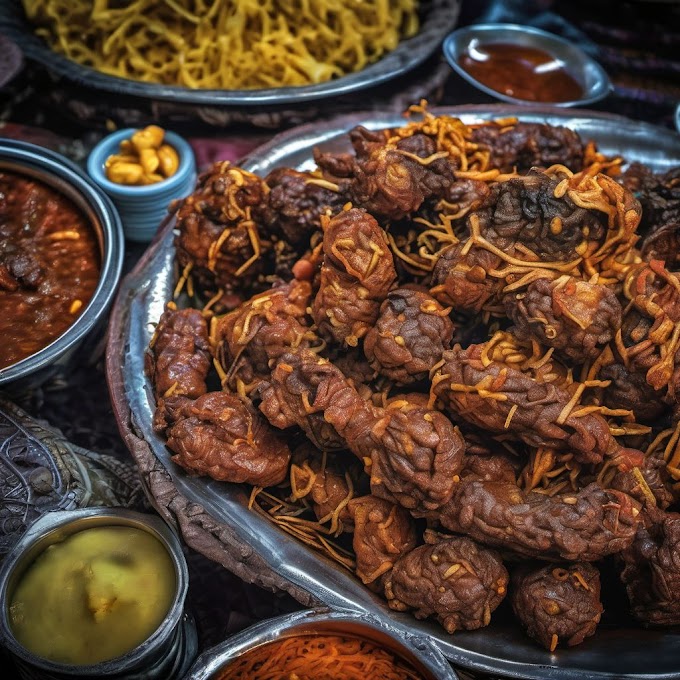

Chinese desserts, steeped in tradition and reflecting thousands of years of culinary evolution, offer a diverse and fascinating journey for the taste buds. From ancient times to modern influences, Chinese desserts encompass a wide range of flavors, textures, and techniques that highlight the country's vast culinary landscape. Let's explore this intricate world of Chinese desserts in great detail.
1. **Mooncakes (Yuebing)**:
Mooncakes are iconic Chinese desserts associated with the Mid-Autumn Festival. These round pastries symbolize unity and togetherness. They come in various flavors and fillings, with lotus seed paste and salted egg yolks being popular choices. Modern variations may also feature chocolate, fruits, or even ice cream fillings.
2. **Red Bean Paste (Hong Dou Sha)**:
Red bean paste is a fundamental ingredient in Chinese desserts. Made from boiled and mashed red beans, it's sweetened with sugar to create a smooth, velvety paste. This paste serves as a filling for numerous traditional treats like buns, pastries, and pancakes.
3. **Tangyuan**:
Tangyuan, also known as glutinous rice balls, are often enjoyed during the Lantern Festival and Winter Solstice Festival. They are typically filled with sweet sesame, red bean paste, or peanut butter, symbolizing family unity and harmony.
4. **Sesame Balls (Jian Dui)**:
Jian Dui are deep-fried glutinous rice balls coated with sesame seeds on the outside, resulting in a crispy shell and a chewy interior. The filling often comprises sweet lotus seed or red bean paste. They are popular during the Lunar New Year and other celebrations.
5. **Mochi (Nian Gao)**:
Nian Gao, a sticky rice cake made from glutinous rice flour and sugar, is a must-have during Chinese New Year. Its name is a homonym for "tall and prosperous," symbolizing growth, progress, and the promise of a better year. It's often sliced and steamed or pan-fried before serving.
6. **Egg Tarts (Dan Ta)**:
Egg tarts, inspired by Portuguese pastéis de nata, have been embraced in Chinese cuisine. They consist of a flaky pastry shell filled with a creamy egg custard. Variations include milk tarts or fruit-topped tarts, adding layers of taste and texture.
7. **Bingtanghulu**:
Bingtanghulu are skewered candied hawthorn fruits, traditionally found during winter. The tartness of the hawthorn is balanced with a crunchy, sweet sugar coating. Nowadays, you can find various fruits like strawberries and kiwis prepared in a similar manner.
8. **Douhua (Tofu Pudding)**:
Douhua is a silky, soft tofu pudding often served with sweet syrup or a ginger-infused syrup. It's a popular dessert, especially in southern China. Toppings can include red bean paste, peanuts, or even small tapioca pearls.
9. **Fruit-based Desserts (Shui Guo Liao Li)**:
Fresh fruits, often in their natural form or as fruit salads, are commonly served as a light and refreshing way to end a meal. Tropical fruits like mango, lychee, and dragon fruit are particularly popular.
10. **Snow Skin Mooncakes (Bing Pi Yuebing)**:
Snow skin mooncakes are a contemporary variation of traditional mooncakes. Their outer layer is made from glutinous rice flour, giving them a soft, slightly chewy texture. They often contain fruit-based fillings and are consumed chilled, making them a delightful summer dessert.
11. **Osmanthus Jelly (Guihua Gao)**:
Osmanthus jelly is a translucent dessert made from osmanthus flowers and a type of gelatin or agar-agar. It offers a delicate floral aroma and is often served with a drizzle of honey.
12. **Almond Tofu (Xing Ren Dou Fu)**:
Almond tofu is a popular dessert made from almonds, sugar, and agar-agar or gelatin. It has a silky, tofu-like texture and a delightful almond flavor. It's often garnished with fruits or a syrupy sweet sauce.
13. **Eight Treasure Rice (Ba Bao Fan)**:
Eight Treasure Rice is a traditional dessert often enjoyed during the Laba Festival. It includes glutinous rice mixed with eight different sweet ingredients, such as red dates, raisins, candied fruits, and nuts, resulting in a rich, flavorful dish.
14. **White Rabbit Candy Ice Cream (Bai Tu Nuo Bing Qi Lin)**:
Inspired by the famous White Rabbit Candy, this ice cream embodies the creamy, milky taste of the beloved treat. It's a modern adaptation, showcasing the integration of traditional flavors into contemporary desserts.
Chinese desserts, deeply rooted in tradition and symbolism, offer a delightful spectrum of tastes and textures. Whether you're savoring the intricacies of a delicate mooncake or relishing the sweetness of red bean paste, each dessert tells a story of culture, celebration, and the joy of indulgence. Exploring the diverse world of Chinese desserts is an invitation to appreciate the rich culinary heritage and vibrant flavors of China.






%20(1).png)

